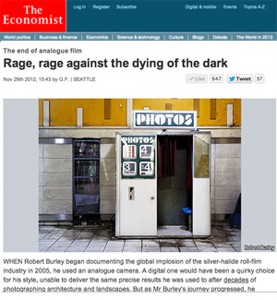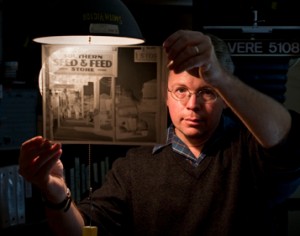This recent review by Guardian writer Sean O’Hagan discusses the book as one that explores the end of materiality.

This recent review by Guardian writer Sean O’Hagan discusses the book as one that explores the end of materiality.
 This question has been raised many times – in many emails I’ve received. For those who have read my book you’ll note that I don’t try to answer this difficult question. My personal hope is that film won’t disappear – I’d like to continue using it. However, I realized many years ago this decision won’t be up to me or any of the other artists that want to continue using film. This is a difficult and complex discussion – and for this reason I welcomed a review of my book by Economist writer Glenn Fleishman. Fleishman once worked for Kodak in the 1990’s – a time when it appeared as though the largest manufacturer of photographic products had the future impact of digital technologies well in hand. When I spoke with Fleishman, he immediately understood the idea behind my project and describes the book as, “full of poignant insights, both visual and literary, into a bygone technological era.”
This question has been raised many times – in many emails I’ve received. For those who have read my book you’ll note that I don’t try to answer this difficult question. My personal hope is that film won’t disappear – I’d like to continue using it. However, I realized many years ago this decision won’t be up to me or any of the other artists that want to continue using film. This is a difficult and complex discussion – and for this reason I welcomed a review of my book by Economist writer Glenn Fleishman. Fleishman once worked for Kodak in the 1990’s – a time when it appeared as though the largest manufacturer of photographic products had the future impact of digital technologies well in hand. When I spoke with Fleishman, he immediately understood the idea behind my project and describes the book as, “full of poignant insights, both visual and literary, into a bygone technological era.”
Fleishman experienced a lively response to his article from film users around the globe who suggested he (like me) was exaggerating and sensationalizing the demise of their medium. After all, there is still film being made and people are still using it so why shouldn’t it continue forever!? I was pleased to see him reply with this comment:
The future is now.
There is a point beyond which the industrial scale necessary to produce the chemicals, substrate, and final product at a price individuals are willing to pay will no longer pencil out. Film cannot be made both well and affordably (key point that) without a large-scale market. This is the reason for the demise of many well-loved films.
When an industry loses a massive portion of its market in a matter of years, and has the prospect of selling substantially less in each subsequent year, one has to wonder how long the industry remains viable.
The question remains: Can film be produced as an artist’s material in the future? I still don’t have a clear answer to this question. I have high hopes for black and white materials (thank you Ilford) but I fear my color negative films are not long for this world. A follow-up article in Digital Trends titled, “Economics, not digital, is what’s killing off analog film” was posted a few days later. Sadly, making film is not like manufacturing other anachronistic media (i.e. vinyl records) – it’s extremely complicated and without a large customer base – it becomes difficult to keep those factories running.

A recent article in the Washington City Paper discusses a end-of-year decision by the Library of Congress to discontinue its longstanding service of providing the public with silver-gelatin prints created from the negatives in its photography collection. For the last fifty years this service has allowed individuals like myself to acquire masterpieces of twentieth century photography for a nominal sum. When I come downstairs each morning I confront a well-known Walker Evans photograph (Roadside Fish and Produce Stand with Young Men Holding Watermelons) hanging on my wall. It was created in 1936 near Birmingham, Alabama – as part of a commission for the Farm Security Commission that involved Evans along with numerous artists including Dorthea Lange and Gordon Parks, each photographing poor rural areas of the American South. A variation of this photograph can be found in the collection of the Metropolitan Museum of Art but I think I have the better version (it’s the one with young girl in the shadows gesturing to the camera in a kind of curtsy). The print was purchased from the Library of Congress in the 80’s and printed by a government darkroom technician who used the original negative created by Evans. The fact that my print comes from the object that was held, exposed and developed by Evans in 1936 suddenly becomes all the more the meaningful as the Library of Congress moves to an all digital system for researchers.